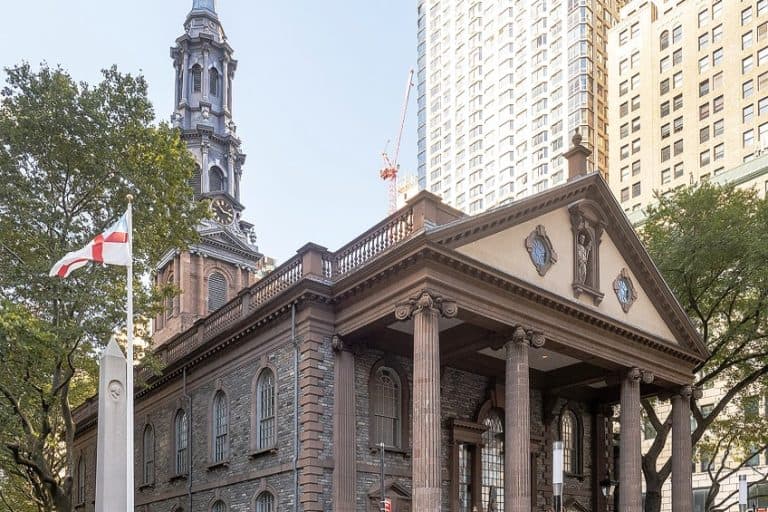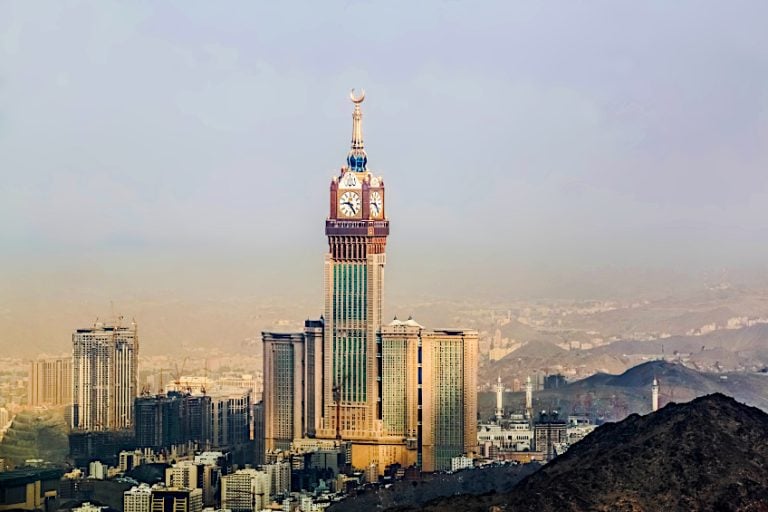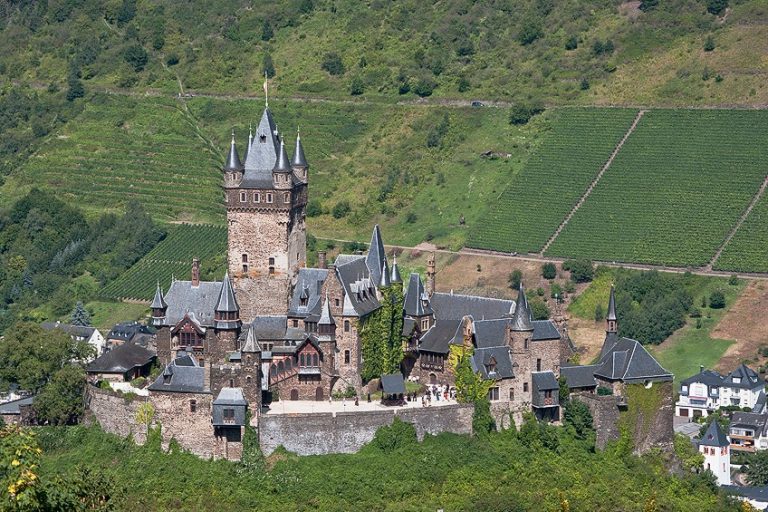Arch of Constantine – Arch of Constantine Architecture and History
Why was the Arch of Constantine built, to begin with? The Roman triumphal arch, the Arch of Constantine, was constructed in dedication to Constantine the Great. When was the Arch of Constantine built, and who built the Arch of Constantine? The Roman Senate authorized the construction of the Arch of Constantine to celebrate the emperor’s triumph in 312 CE at the Battle of Milvian Bridge against Maxentius. To learn more about the significance of this iconic and important arch, read further below!
An Exploration of the Arch of Constantine
| Architect | Constantine I (306 – 337 CE) |
| Date Completed | 315 CE |
| Function | Roman Triumphal arch |
| Location | Regio X Palatium, Rome, Italy |
The arch is part of the Via Triumphalis, the road used by military commanders as they entered Rome in a triumphal parade, and is located between the Palatine Hill and the Colosseum. But, what is the Arch of Constantine made of? It is made of marble-covered concrete. Regarding the Arch of Constantine’s architecture, it features a three-bay design with detached columns that was initially utilized for the Roman Forum’s Arch of Septimius Severus and was thereafter replicated in many other arches that are now long since gone. Despite being dedicated to emperor Constantine the Great, the majority of the sculptural ornamentation consists of reliefs and sculptures from previous triumphal monuments that had been dedicated to Hadrian, Trajan, and Marcus Aurelius. It is ranked as the biggest Roman triumphal arch. Let’s take a look at the Arch of Constantine’s facts, such as its history and significance.
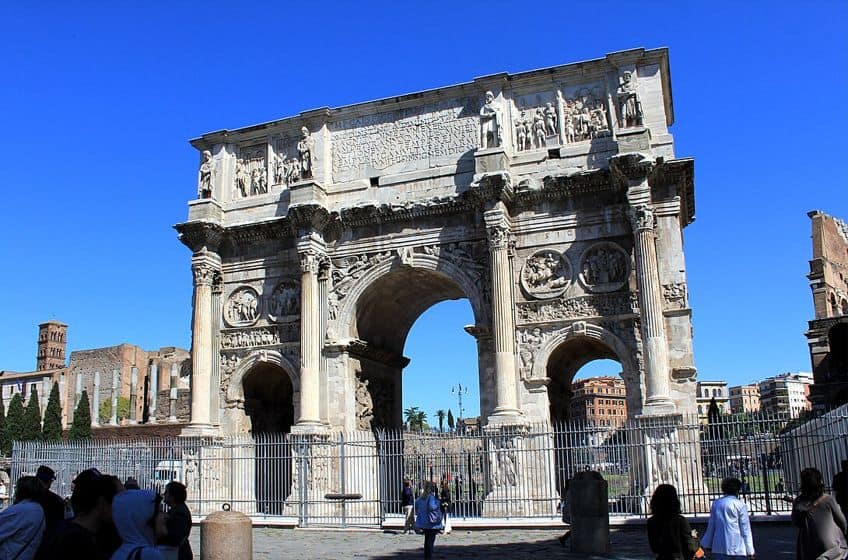
The History of the Arch of Constantine
The Senate built the Arch of Constantine to celebrate 10 years of his rule and his triumph against then-ruling emperor Maxentius. It was also built to commemorate the decennalia, a series of games held every 10 years under the Roman Empire. Yet, it was when the emperor came to Rome on the 29th of October, 312 CE, amidst much celebration that the monument was actually commissioned by the senate of Rome. Within two months of his arrival, he once again left Rome and did not return for 14 years. During the Medieval Era, the arch was integrated into one of ancient Rome’s family fortresses.
Restoration work started in the 18th century, with the most recent excavation taking place in the late 1990s, shortly before the Great Jubilee in the year 2000. In the Summer Olympics of 1960, the arch was used as the marathon event’s finish line.
The Symbolism of the Arch of Constantine
Maxentius’ reputation in Rome was shaped by his contributions to public building projects. By the time he became emperor in 306 CE, Rome had become more inconsequential to empire governance, with most emperors preferring to reside somewhere else and focused on protecting the empire’s unstable borders, where they typically established new settlements. Maxentius, unlike his predecessors, focused on rebuilding the capital. As a result, Constantine was seen as the one who deposed one of Rome’s greatest patrons, and he wanted to gain credibility. Considerable controversy clouded Constantine’s funding of public works during this time, as he set out to methodically erase any public memory of Maxentius. As a result, there is significant controversy about the patronage of early public constructions in the 4th century, such as the Arch of Constantine, which may have previously been the Arch of Maxentius. Another theory suggests that it is an older work from Hadrian’s era that was modified during Constantine’s rule.

Sculptural Style of the Arch of Constantine
The Arch of Constantine is a significant example, commonly noted in art history studies, of the 4th-century stylistic shifts and the disintegration of the classical Greek standard of design during the late Roman era. It was interpreted as an indication that Rome was in decline, and that it would soon be superseded by Constantine’s establishment of a new capital at Constantinople in 324 CE. The difference in styles between the re-used reliefs of Hadrian, Trajan, and Marcus Aurelius and those sculpted specifically for the arch is rather striking.
It is often regarded as the most remarkable extant public monument from Late Antiquity Rome, but it is also among the most contentious in terms of its history and interpretations.
Historians have compared a lion-hunting roundel of Hadrian, which is still firmly entrenched in the lineage of late Hellenistic art, in which there is an illusion of wide open space in which the subjects move freely and with comfortable self-assurance with a subsequent frieze in which the people are squeezed and locked between two imaginary planes and so snugly compacted within the frame that there is no freedom of movement in any direction. The figures in 4th-century reliefs are arranged geometrically in a manner that only makes sense in relation to the observer. The classical canon of proportions has also disappeared.
The heads are abnormally big, the trunks are square, and the legs are short. Variations in the physical size of individuals emphasize differences in status and significance that the 2nd-century artists expressed through nuanced compositional methods inside an otherwise casual grouping. Elaboration of details and variation of surface textures are also gone. The faces seem chopped rather than sculpted, the hair is shaped like a cap with some basic stippling, and fabric folds are expressed simply by deep drill lines. The commission was undoubtedly significant, although rushed, and the workmanship must be viewed as embodying the highest possible craftsmanship in Rome at that period. The problem of how to explain what appears to be a decrease in both aesthetic and implementation has generated a great deal of debate.

Potential variables introduced into the debate include a collapse of the transfer of artistic abilities as a consequence of the 3rd century’s economic and political disruption, influences from Eastern as well as other pre-classical provincial styles from across the Empire, the introduction of public artworks of a simplified aesthetic that had been employed by the less affluent all through the rule of Greek models, and deliberately eschewing what the classical styles had come to symbolize. The sculptors of emperor Constantine’s era were increasingly concerned with symbolism – both religious and historical in meaning. The ascent of Christianity to state support cannot be blamed because the changes in artistic style occurred before then. The aesthetic parallels to Septimius Severus and Titus’ previous arches, as well as the integration of spolia from the reigns of other preceding emperors, may be seen as an intentional tribute to the history of Rome.
The Iconography of the Arch of Constantine
The arch is richly adorned with pieces of ancient monuments that take on new significance in the framework of the Constantinian structure. As it commemorates Constantine’s triumph, the new friezes depicting his war in Italy communicate the essential message: admiration for the emperor, both in combat and in public duties. The older imagery serves this goal as well: ornamentation from the “golden period” whose works belonged to the 2nd-century emperors was reused, helping to place Constantine in the same category as these great emperors, and the contents of the works evoke images of a successful and virtuous ruler.
Another reason for the utilization of old art is that there was not enough time between the beginning of the construction and the dedication, therefore the architects repurposed existing artwork to compensate for the lack of time to produce original works.
It’s also possible that so many older pieces were incorporated because the designers didn’t believe the artists of their day could do any better than what had previously been accomplished by other older and more talented artists. It has been hypothesized that the 4th century Romans lacked the artistic talent to make suitable artworks, were conscious of this, and therefore took pieces from the ancient buildings to embellish their modern structures. This idea has diminished in recent years as the art of Late Antiquity has gained recognition in its own right, and it is likely that a combination of those theories is valid.
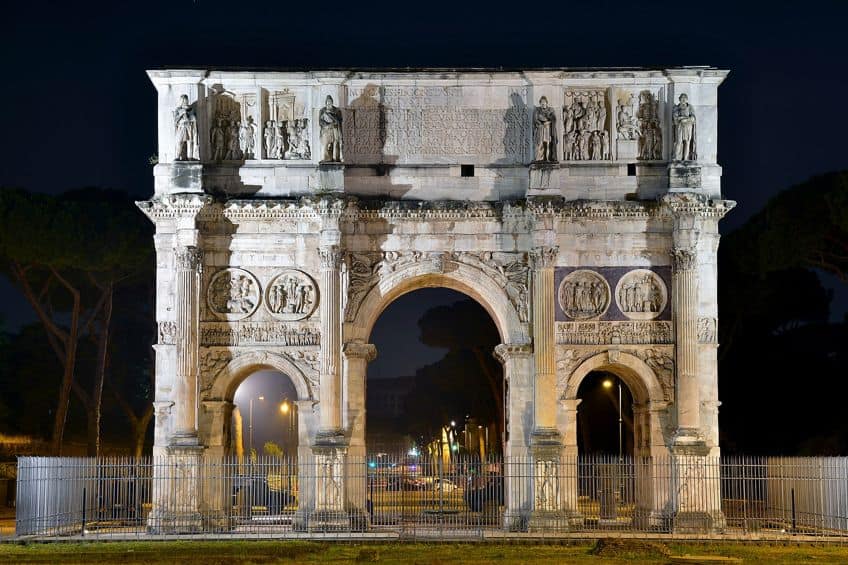
That completes our look at the Arch of Constantine’s facts and history. From the Arch of Constantine’s architecture to its symbolism, it has been the source of much derision and debate due to its utilization of older (and far superior) artworks, sculptures, and friezes. Many theories have been suggested regarding the reason for this drop in quality over the years, including a break in the artistic traditions, where the skills needed to create fine artworks were not effectively passed on down the generations.
Frequently Asked Questions
When Was the Arch of Constantine Built?
Construction on the arch began in 312 CE, following the emperor’s success in the battle against Maxentius. It was completed just three years later in 315 CE. Due to this rushed construction period, it is thought that artworks were taken from other monuments to complete the arch in time.
Why Was the Arch of Constantine Built?
It was constructed to celebrate the defeat of the emperor Maxentius. However, the former emperor had been much liked by the people of Rome for his public works, so Constantine had to do something to win their respect and allegiance. It was decided by the senate to build a monument for his achievements upon his return to Rome.
Who Built the Arch of Constantine?
The Roman senate gave the go-ahead for the project. It is believed that Constantine commissioned a team of engineers and artists from Rome. However, there are many people who argue that based on the design, it might have actually already been in existence when he came to power and simply renovated and modified.
What Is the Arch of Constantine Made Of?
The Arch of Constantine was constructed from brick-faced concrete which was then covered in marble. It also contains many sculptures, roundels, and friezes. However, it is not known which of the sculptural works were created before the construction of the arch.
Justin van Huyssteen is a freelance writer, novelist, and academic originally from Cape Town, South Africa. At present, he has a bachelor’s degree in English and literary theory and an honor’s degree in literary theory. He is currently working towards his master’s degree in literary theory with a focus on animal studies, critical theory, and semiotics within literature. As a novelist and freelancer, he often writes under the pen name L.C. Lupus.
Justin’s preferred literary movements include modern and postmodern literature with literary fiction and genre fiction like sci-fi, post-apocalyptic, and horror being of particular interest. His academia extends to his interest in prose and narratology. He enjoys analyzing a variety of mediums through a literary lens, such as graphic novels, film, and video games.
Justin is working for artincontext.org as an author and content writer since 2022. He is responsible for all blog posts about architecture, literature and poetry.
Learn more about Justin van Huyssteen and the Art in Context Team.
Cite this Article
Justin, van Huyssteen, “Arch of Constantine – Arch of Constantine Architecture and History.” Art in Context. April 25, 2023. URL: https://artincontext.org/arch-of-constantine/
van Huyssteen, J. (2023, 25 April). Arch of Constantine – Arch of Constantine Architecture and History. Art in Context. https://artincontext.org/arch-of-constantine/
van Huyssteen, Justin. “Arch of Constantine – Arch of Constantine Architecture and History.” Art in Context, April 25, 2023. https://artincontext.org/arch-of-constantine/.



